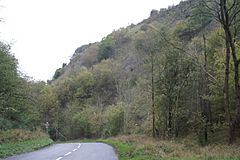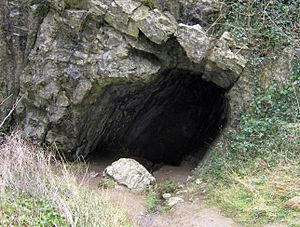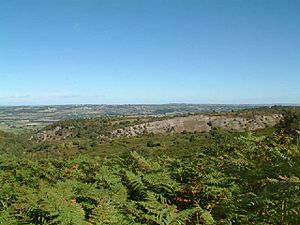Burrington Combe facts for kids
| Site of Special Scientific Interest | |
 |
|
| Area of Search | Avon |
|---|---|
| Coordinates | 51°19′17″N 2°45′02″W / 51.32140°N 2.75047°W |
| Interest | Biological and Geological |
| Area | 139.1 ha (344 acres) |
| Notification | 1952 |
Burrington Combe is a deep valley or gorge located in North Somerset, England. It's found near the village of Burrington, on the northern side of the Mendip Hills. This area is known for its natural beauty.
The word "combe" means a steep-sided valley. Burrington Combe is a gorge cut through Carboniferous Limestone hills. Even though there's no river running through it now, it was likely formed by water long ago. Many cave entrances are found here. People have lived in these caves for over 10,000 years. An ancient hillfort was also built next to the combe during the Iron Age. The unique rocks here also support many different kinds of plants.
A famous story says that Augustus Montague Toplady wrote the hymn Rock of Ages while hiding from a storm in the combe. However, some experts now think this story might not be true.
Contents
What is Burrington Combe?
Burrington Combe is a special type of valley called a gorge. It was carved out of Carboniferous Limestone, which is a type of rock formed from the shells and skeletons of sea creatures millions of years ago. The exact way this gorge was formed is still a bit of a mystery.
Water flowing from Black Down helped shape the combe. It exposed different layers of rock. These include older sandstones and various types of limestone and mudstone. The northern part of the combe was once the bed of a river called the Congresbury Yeo.
Exploring the Caves of Burrington Combe
Burrington Combe is famous for its many caves. These caves have been important places for humans for a very long time. Archaeologists have found signs of people living here during the Upper Paleolithic period (the Stone Age). They also found some of the oldest scientifically dated cemeteries in Great Britain from the Bronze Age.
Some of the well-known caves include Aveline's Hole, Sidcot Swallet, and Goatchurch Cavern. A "swallet" is a natural hole or sinkhole where water drains underground.
Goatchurch Cavern
Goatchurch Cavern is a large cave, about 1,500 meters (nearly a mile) long. It goes down about 61.5 meters (200 feet) deep. People first wrote about this cave in 1736. Lead miners explored it in the 1800s. Around 1901, the owner tried to make it a show cave for visitors, but it didn't work out.
In the 1920s, explorers found bones from ancient animals inside Goatchurch Cavern. These included bones of mammoths, bears, hyenas, and cave lions. In 2003, special marks were found on the cave walls. These marks, shaped like the letter W, are thought to be "ritual protection marks." People might have made them between 1550 and 1750 to protect themselves from bad luck.
Aveline's Hole
Aveline's Hole is another very important cave. It holds the earliest scientifically dated cemetery in Great Britain. Scientists believe the human bone fragments found here are between 10,200 and 10,400 years old. These bones came from about 21 different people.
On the walls of Aveline's Hole, there are also crosses carved into the rock. These carvings are believed to be from the early Mesolithic period, which was just after the last Ice age.
Ancient Hillfort
High above the combe, on its eastern side, is an ancient Iron Age hillfort called Burrington Camp. It's about 100 meters (330 feet) long and 80 meters (260 feet) wide. This fort also shows signs of being used during the Romano-British period.
A Special Place for Nature
Because of its interesting plants and geology, Burrington Combe is a very special place. In 1952, an area of 139.1 hectares (about 344 acres) was named a Site of Special Scientific Interest (SSSI). This means it's protected for its natural importance.
The grassy areas on the limestone hills have many different wildflowers. You can find plants like Salad burnet, Knapweed, Rock-rose, and Wild thyme. On the higher, more acidic slopes, you might see goldenrod, wood sage, and common bent grass. There are also bushes like hawthorn, mountain ash, gorse, and elder. Several of the caves in the combe are home to different kinds of bats.
Geologists recognize the combe as a fluvial karst feature. This means it's a landscape shaped by water dissolving soluble rock, like limestone. It also partly crosses an older, buried gorge from the Triassic period.
The Legend of Rock of Ages
There's a popular story about the famous hymn Rock of Ages. The legend says that Augustus Montague Toplady (1740–1778), who was a church leader in nearby Blagdon, wrote the hymn while taking shelter from a thunderstorm in Burrington Combe. He supposedly hid under a large rock, which was later named "Rock of Ages" after the hymn.
However, this story might just be a legend. Many historians believe the connection between the hymn and Burrington Combe only became popular long after Toplady died, around the 1850s. Toplady had actually left the area around Burrington Combe in 1764, well before the hymn was published in 1776. So, while it's a nice story, there's no strong proof that the hymn was actually written there.
The local area, including Black Down and Ellick Farm, is also mentioned in poems by C. H. Sisson.



